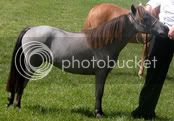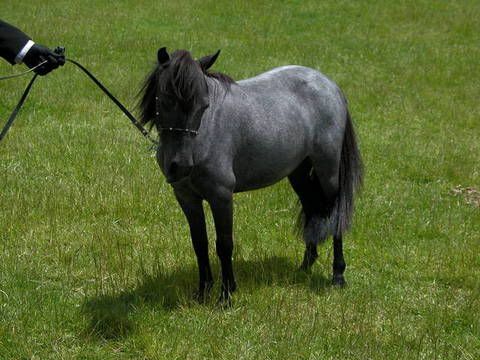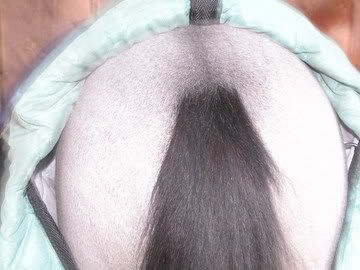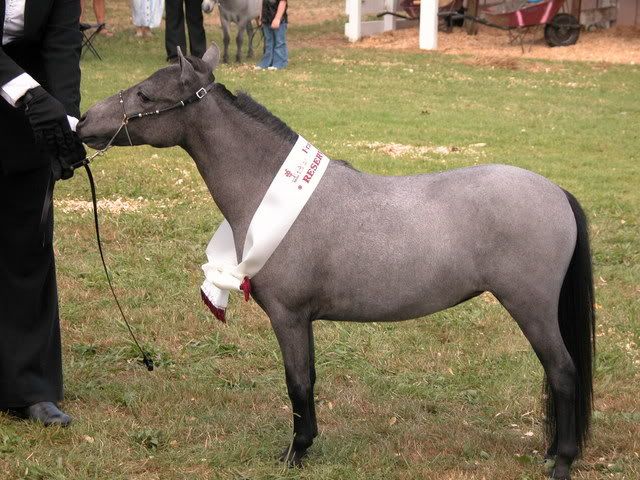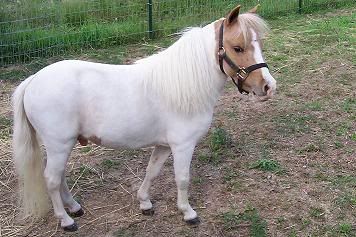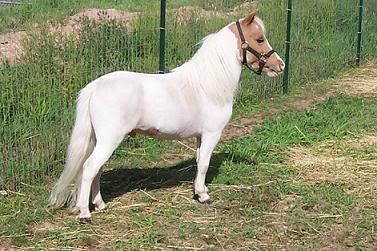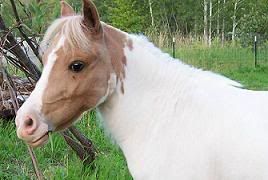SunQuest
Well-Known Member
- Joined
- Dec 2, 2002
- Messages
- 1,280
- Reaction score
- 0
Hi Susanne,
I just love Mingus!!
Well, I am one that has quit posting critiques as I got tired of the agrivation of doing so.............
But, here is a post that I looked up in the archives that I had posted well over a year ago. The archive was missing the picture because of a server change, so I decided to copy that post to here. It gives a good general basis of what one looks for, even if I am not deadly accurate in my placement of the lines. I don't have a larger picture to work from, and well, with this boy being so HUGE, you couldn't see any of the points on him easily in real life, forget in the picture. Lucky for me, he isn't that big now!

Anyway, here is the post...
This is SQ JD Black Label.

He is an AMHR gelding that is 35.50 inches tall and 4 years old in this picture. He is out of a mare that is 37" and was breed for miniature harness racing, and he is by our 33" Mountain High Stallion that is a Whittmaack's Mickey Mouse grandson. He is shown in pasture condition and is VERY VERY overweight. I estimated that he was at least 50 to 75 pounds overweight in that picture (normally weighs approx. 300 pounds and the tape measurements indicated that he was around 350 pounds in this photo!) There are no severe flaws or nasty attitude that forced us to geld him. It is just that we thought an ok "B" stallion would be a great "B" gelding. And since we own both parents, well...
He is not standing square in this picture and the near hind (right hind) leg is forward making it even harder to judge him along with the photographer taking the picture from too low of an angle for an ideal picture. And it was a really windy day which you can see that his tail is blown off to one side as well. All of this causes his tail to look much lower set than it is in reality, and since he isn't set up, he hasn't "popped" his back and hind quarters into a show stance that would make his croup more level. This horse has been shown locally and has placed in every class he has ever been in, including some large open breed classes.
What you can't see in this picture and what I don't have any pictures of him are the front and rear shots, and looking down his back line. I will tell you that his front and rear legs as viewed from directly in front of and behind him are very straight. He does not toe out or toe in. His bite is perfect. When standing behind him and looking down along his back bone, the back is straight from tail to poll and the line drawn from the left and right sides of the hip at "B" is perpendicular to the back bone.
Now for critiquing what we can see.
First thing I would tell someone who wanted to show JD is to exercise him and get that extra 50 to 75 pounds off of him!!! This horse is no way in show condition in this picture and it is NOT fare to judge him due to that, but I will anyway as this if the best picture I have.
Also, please note that the location of the lines are approximate as this horse is so fat that unless one palpated him and put markers on him, one would have a hard time of finding the absolute point in the pictures. (And of course anyone who has tried to draw on a computer knows that is hard in it's self!)
Lets talk first about overall balance. To determine balance, you would look at the purple lines labeled A (point of buttocks), B (point of hip), C (point of withers), and D (point of shoulder). If you measure the distance between these lines, they should all be equal. On JD, they are not exactly equal, but in general they are better than 50% of the minis that I see, making him average to a little above average. If I could change one thing on the balance, I would move line C back towards line B. Because JD's shoulder is a little steep, it is making his front end lighter and back longer than the rear end. So in other words, From point of withers ( C) to point of shoulder (D) is less than the distance from point of buttocks (A) to point of hips (B). And the distance from the point of the hips (B) to point of the withers ( C) is longer than the distance from the point of buttocks (A) to the point of hips (B) because of the steep shoulder.
Next, how did I determine that the distance from line A to B is the correct one to refer the other distances too? This is a little complex. First, I looked at the distance from his poll (Between the ears) to the point of withers. I compared that to the distance from lines A to C. On JD, these distances are almost equal. That means that his neck length is, in theory, just long enough for his body length although I would prefer a little longer neck due to my own preferences. Next, I looked specifically at his hind end. What a person needs to know is that you want a hind end that is ideally 33.33% or better of the body length as the hind end is the "engine" of the horse. This is where the power of a horse comes from. Now, how to figure out that percentage. First take a photo from dead center of the horse like I did here. Next, draw a line from the point of the buttocks (G or K) to the point of hip (H), which is represented by a red line. Then draw a second line from the point of buttocks (G or K) to the point of shoulder (L), which is represented by the blue line. I then measured these two lines. In my photo the red line (G to H) measured .875" and the blue line (K to L) measured 2.625" in length. Next, to get the percentage divide the red line length by the blue line length (.875 divided by 2.625 = .3333 with the "3" repeating forever). Now convert the decimal number into a percentage by moving the decimal 2 places to the right. The measurement is now 33.33 %. This means that this horse's rump comprises 1/3 of the horse's overall body length. This is VERY good for a mini. BUT.... in general, this is on the high side of average on most breeds of horses. Anything above 33% is considered above average, and anything below 33% is considered below average. Further, anything below 30% is considered very poor. Now on minis, I always have to question is the rump and shoulder too week and the back to long, especially since it seems like most minis are too long in the back (from lines B to C). So now, when I look at JD, I know the rump area is right for his overall length. It is the back that is too long. And the shoulder is what is causing that to be this way.
Lets now look at JD's loin and lumbar area. Because I don't have a top view of the horse to show you, I will do the best I can to describe this area and what one wants from it. This area is CRITICAL to connecting the hind end (engine) to the rest of the car... err horse. Think of the loin as the horse's transmission. It doesn't matter how nice the horse's engine is the transmission doesn't work well. Several things to remember in regards to the back. You want most of the back to be taken up by the space that the ribs occupy. From the end of the vertebrae where the last rib joins in to the back to the Lumbar sacral joint (E) needs to be as short as possible. While miniatures do not carry weight on their backs, this area is even more important in the riding horse and the brood mare. And the longer this area is, the higher the chances of a horse becoming sway backed as the ligaments and tendons are longer and can be injured easier. So, what one wants to see is the point represented by the line at E be as far forward towards line B. Ideally, E would be almost in line with B or F. (Physically, point E can NOT be past the point of the hips (F)) So, if you view the horse from above the back, you would draw a line connecting the left and right points of the hip. Then from each side of the hip you would draw a line to where the hip physically connects to the back (Lumbar sacral joint). Ideally you want this to make a really really wide triangle with the point of the triangle being as close to the base of the triangle (the point of the hips (F)) as possible.
On JD, there is a lot of room for improvement in this area. BUT, on most minis this is one of the weakest areas on the horse! And many times it is one of the most overlooked areas as well! I hear all to often that I want a mare with a long back so that there is plenty of room for the foal. In reality you want a horse with a long back that is taken up by mostly ribs and a short lumbar area. This way the foal is putting less stress on the horse's weakest point of the back and the fetus is better protected by the bone structure of the mare. If I have to choose between a horse with a weak lumbar area and one with a weak hip, I would take the one with the weak hip and rate it higher than the one with a weak lumbar area, although in reality, the two are often very connected and where there is a week hip there is often a weak or overly long lumbar area as well. The reason I say that I would place a weaker hip over a weak lumbar area is that a horse with a week lumbar area has a weak back which makes it harder for the hind end to drive a horse forward and for the horse to collect. Also, that area being week predisposes a horse to a life time of possible back problems as the tendons, ligaments and muscles in that area are more likely break down as the horse ages turning the horse into a sway backed animal. This area is kind of related to the lower back area in humans. Any of you with lower back issues know the problems this can create.
Now, the triangle in red going from the point of the buttocks (G) to the point of the hip (H) to the stifle joint (J). If you look at this triangle, the sides are all just about equal. This means that the hip is not overly weak on JD. If the hip was week, the line from G to J would be shorter than the line from G to H. In other words, the stifle would be week and the hip line would move more vertical making the overall distance from lines A to B shorter. On top of that, the tail would be set lover on the horse as well.
Ok, how else does that steep shoulder effect JD? The angle of his shoulder is making his natural head and neck set lower. Look at the underline side of his neck. While that line along the bottom of the neck is smooth, indicating he is not ewe necked, I would like to see where the neck joins the chest to be a little higher up on the chest. Of course to do that, the withers would have to move back towards the rump some and the shoulder angle would then flatten out some and allow the neck to come out of the body at a higher angle. But I would not fault this horse if compared to a QH. But compare to the Arab, there would be fault.
Lets briefly look at his hooves and pasterns (area just above the hooves). If you look at the front edge of the front leg where the white line is drawn, you will notice that the white line is approximately parallel to the white line showing the slope of the shoulder. THIS IS IMPORTANT! Your horse's feet should be trimmed so that these two lines are parallel That means the pastern and hoof angles are the same so that they create an unbroken line! Now on JD, he is leaning forward so the pastern angle looks a bit more sloped, but in reality it isn't when he stands natural. Now look at the white line showing the pastern angle on the hind legs. Notice that this line is almost parallel to the red line running from G to J. Again THIS IS IMPORTANT! This angle should match. I can't begin to tell you all how many horses I have seen with the hooves trimmed too steep and causing the horse to have a broken line from pastern to toe on the hoof which in turn causes horses to go club footed, especially when trimmed that way at a young age! And any horse that is club footed should NOT be considered sound. The feet and legs will not hold up to the pounding that they were designed to take. And if the hoof angle is steep enough, the coffin bone that lays in the hoof will be effected. Think of it as a woman who walking for 8 hours steady while wearing 4" heels! On his hind legs, if you square him up and run a verticle line from the point of the buttocks to the ground, the back of his cannon bone would lay fully along that line which is good. This means that he is not camped under or camped out. And although it is difficult to see due to him leaning forward to reach for an invisible treat, his front legs when viewed from the side are straight as well. A line running through the center of the fore arm, knee, and cannon bone is straight. He is neither over or under in the knee. So in general he has good legs.
Now the head. While JD has a better head than his dam's head, there is still room for improvement here. I would like to see is head a tiny bit shorter than it is. His neck is just barely shy of being 1 and 1/2 times the length of his head. His larger head makes him appear to be heavier on the front end of the horse. As far as the proportions on the head it's self, I would like to see the nose (between the muzzle and the eye) to be a little shorter. Again a front shot of the head would show the proportions better. From the front, ideally the poll to a horizontal line connecting the eyes would be the same distance apart as the line from the eyes to where a properly fitted halter noseband would lay which also would be the same distance apart from where the halter noseband to the end of the upper lip would be. What you want is a head that is 3 equal parts. JD is pretty good about his proportions, but his nose area is a little longer... more like a Thoroughbred. I prefer Arab, so would like the nose to be a little shorter. Of course he would look good with his overall build with the head just shrunk down a little. Again, the head size on minis compared to the body size almost always gives away that one is looking at a mini and not another breed. His throat latch could be cleaner, but again that relates to the neck set and the fact that his steep shoulder causes his neck to be lower in carriage. The lower segment of the 3 parts of the neck is longer than the upper. This means that he will have a slightly harder time flexing the curve at the poll and counter flexing the curve where the neck joins the body to obtain true collection. Ideally I would like to see the lengths of those two curves switched where the straight part of the neck (middle part) has a shallow (shorter) curve that joins the body, and a longer deeper curve at the poll that would open the throat latch area and allow the horse to tuck at the poll.
And finally, JD would have longer looking legs if we conditioned him and made him get to a proper weight as well! This picture just does not do him justice. But I love this boy. He is super calm when handled and I can trust him. Overall he is well built and presents a pleasing picture when he moves and has a kind eye. He can obtain a true extended English trot with a moderate amount of knee action. He basically has normal large horse movement and doesn't waddle when viewed from behind. (Although his tummy does jiggle like a bowl of jelly! LOL) This is a horse that I would trust with a beginner when he is fully trained to a cart. And that was what I was after when we bred his parents. His faults are not as great as either of his parents. Truly he is what I was hoping would happen with that cross.
I just love Mingus!!
Well, I am one that has quit posting critiques as I got tired of the agrivation of doing so.............
But, here is a post that I looked up in the archives that I had posted well over a year ago. The archive was missing the picture because of a server change, so I decided to copy that post to here. It gives a good general basis of what one looks for, even if I am not deadly accurate in my placement of the lines. I don't have a larger picture to work from, and well, with this boy being so HUGE, you couldn't see any of the points on him easily in real life, forget in the picture. Lucky for me, he isn't that big now!

Anyway, here is the post...
This is SQ JD Black Label.

He is an AMHR gelding that is 35.50 inches tall and 4 years old in this picture. He is out of a mare that is 37" and was breed for miniature harness racing, and he is by our 33" Mountain High Stallion that is a Whittmaack's Mickey Mouse grandson. He is shown in pasture condition and is VERY VERY overweight. I estimated that he was at least 50 to 75 pounds overweight in that picture (normally weighs approx. 300 pounds and the tape measurements indicated that he was around 350 pounds in this photo!) There are no severe flaws or nasty attitude that forced us to geld him. It is just that we thought an ok "B" stallion would be a great "B" gelding. And since we own both parents, well...
He is not standing square in this picture and the near hind (right hind) leg is forward making it even harder to judge him along with the photographer taking the picture from too low of an angle for an ideal picture. And it was a really windy day which you can see that his tail is blown off to one side as well. All of this causes his tail to look much lower set than it is in reality, and since he isn't set up, he hasn't "popped" his back and hind quarters into a show stance that would make his croup more level. This horse has been shown locally and has placed in every class he has ever been in, including some large open breed classes.
What you can't see in this picture and what I don't have any pictures of him are the front and rear shots, and looking down his back line. I will tell you that his front and rear legs as viewed from directly in front of and behind him are very straight. He does not toe out or toe in. His bite is perfect. When standing behind him and looking down along his back bone, the back is straight from tail to poll and the line drawn from the left and right sides of the hip at "B" is perpendicular to the back bone.
Now for critiquing what we can see.
First thing I would tell someone who wanted to show JD is to exercise him and get that extra 50 to 75 pounds off of him!!! This horse is no way in show condition in this picture and it is NOT fare to judge him due to that, but I will anyway as this if the best picture I have.
Also, please note that the location of the lines are approximate as this horse is so fat that unless one palpated him and put markers on him, one would have a hard time of finding the absolute point in the pictures. (And of course anyone who has tried to draw on a computer knows that is hard in it's self!)
Lets talk first about overall balance. To determine balance, you would look at the purple lines labeled A (point of buttocks), B (point of hip), C (point of withers), and D (point of shoulder). If you measure the distance between these lines, they should all be equal. On JD, they are not exactly equal, but in general they are better than 50% of the minis that I see, making him average to a little above average. If I could change one thing on the balance, I would move line C back towards line B. Because JD's shoulder is a little steep, it is making his front end lighter and back longer than the rear end. So in other words, From point of withers ( C) to point of shoulder (D) is less than the distance from point of buttocks (A) to point of hips (B). And the distance from the point of the hips (B) to point of the withers ( C) is longer than the distance from the point of buttocks (A) to the point of hips (B) because of the steep shoulder.
Next, how did I determine that the distance from line A to B is the correct one to refer the other distances too? This is a little complex. First, I looked at the distance from his poll (Between the ears) to the point of withers. I compared that to the distance from lines A to C. On JD, these distances are almost equal. That means that his neck length is, in theory, just long enough for his body length although I would prefer a little longer neck due to my own preferences. Next, I looked specifically at his hind end. What a person needs to know is that you want a hind end that is ideally 33.33% or better of the body length as the hind end is the "engine" of the horse. This is where the power of a horse comes from. Now, how to figure out that percentage. First take a photo from dead center of the horse like I did here. Next, draw a line from the point of the buttocks (G or K) to the point of hip (H), which is represented by a red line. Then draw a second line from the point of buttocks (G or K) to the point of shoulder (L), which is represented by the blue line. I then measured these two lines. In my photo the red line (G to H) measured .875" and the blue line (K to L) measured 2.625" in length. Next, to get the percentage divide the red line length by the blue line length (.875 divided by 2.625 = .3333 with the "3" repeating forever). Now convert the decimal number into a percentage by moving the decimal 2 places to the right. The measurement is now 33.33 %. This means that this horse's rump comprises 1/3 of the horse's overall body length. This is VERY good for a mini. BUT.... in general, this is on the high side of average on most breeds of horses. Anything above 33% is considered above average, and anything below 33% is considered below average. Further, anything below 30% is considered very poor. Now on minis, I always have to question is the rump and shoulder too week and the back to long, especially since it seems like most minis are too long in the back (from lines B to C). So now, when I look at JD, I know the rump area is right for his overall length. It is the back that is too long. And the shoulder is what is causing that to be this way.
Lets now look at JD's loin and lumbar area. Because I don't have a top view of the horse to show you, I will do the best I can to describe this area and what one wants from it. This area is CRITICAL to connecting the hind end (engine) to the rest of the car... err horse. Think of the loin as the horse's transmission. It doesn't matter how nice the horse's engine is the transmission doesn't work well. Several things to remember in regards to the back. You want most of the back to be taken up by the space that the ribs occupy. From the end of the vertebrae where the last rib joins in to the back to the Lumbar sacral joint (E) needs to be as short as possible. While miniatures do not carry weight on their backs, this area is even more important in the riding horse and the brood mare. And the longer this area is, the higher the chances of a horse becoming sway backed as the ligaments and tendons are longer and can be injured easier. So, what one wants to see is the point represented by the line at E be as far forward towards line B. Ideally, E would be almost in line with B or F. (Physically, point E can NOT be past the point of the hips (F)) So, if you view the horse from above the back, you would draw a line connecting the left and right points of the hip. Then from each side of the hip you would draw a line to where the hip physically connects to the back (Lumbar sacral joint). Ideally you want this to make a really really wide triangle with the point of the triangle being as close to the base of the triangle (the point of the hips (F)) as possible.
On JD, there is a lot of room for improvement in this area. BUT, on most minis this is one of the weakest areas on the horse! And many times it is one of the most overlooked areas as well! I hear all to often that I want a mare with a long back so that there is plenty of room for the foal. In reality you want a horse with a long back that is taken up by mostly ribs and a short lumbar area. This way the foal is putting less stress on the horse's weakest point of the back and the fetus is better protected by the bone structure of the mare. If I have to choose between a horse with a weak lumbar area and one with a weak hip, I would take the one with the weak hip and rate it higher than the one with a weak lumbar area, although in reality, the two are often very connected and where there is a week hip there is often a weak or overly long lumbar area as well. The reason I say that I would place a weaker hip over a weak lumbar area is that a horse with a week lumbar area has a weak back which makes it harder for the hind end to drive a horse forward and for the horse to collect. Also, that area being week predisposes a horse to a life time of possible back problems as the tendons, ligaments and muscles in that area are more likely break down as the horse ages turning the horse into a sway backed animal. This area is kind of related to the lower back area in humans. Any of you with lower back issues know the problems this can create.
Now, the triangle in red going from the point of the buttocks (G) to the point of the hip (H) to the stifle joint (J). If you look at this triangle, the sides are all just about equal. This means that the hip is not overly weak on JD. If the hip was week, the line from G to J would be shorter than the line from G to H. In other words, the stifle would be week and the hip line would move more vertical making the overall distance from lines A to B shorter. On top of that, the tail would be set lover on the horse as well.
Ok, how else does that steep shoulder effect JD? The angle of his shoulder is making his natural head and neck set lower. Look at the underline side of his neck. While that line along the bottom of the neck is smooth, indicating he is not ewe necked, I would like to see where the neck joins the chest to be a little higher up on the chest. Of course to do that, the withers would have to move back towards the rump some and the shoulder angle would then flatten out some and allow the neck to come out of the body at a higher angle. But I would not fault this horse if compared to a QH. But compare to the Arab, there would be fault.
Lets briefly look at his hooves and pasterns (area just above the hooves). If you look at the front edge of the front leg where the white line is drawn, you will notice that the white line is approximately parallel to the white line showing the slope of the shoulder. THIS IS IMPORTANT! Your horse's feet should be trimmed so that these two lines are parallel That means the pastern and hoof angles are the same so that they create an unbroken line! Now on JD, he is leaning forward so the pastern angle looks a bit more sloped, but in reality it isn't when he stands natural. Now look at the white line showing the pastern angle on the hind legs. Notice that this line is almost parallel to the red line running from G to J. Again THIS IS IMPORTANT! This angle should match. I can't begin to tell you all how many horses I have seen with the hooves trimmed too steep and causing the horse to have a broken line from pastern to toe on the hoof which in turn causes horses to go club footed, especially when trimmed that way at a young age! And any horse that is club footed should NOT be considered sound. The feet and legs will not hold up to the pounding that they were designed to take. And if the hoof angle is steep enough, the coffin bone that lays in the hoof will be effected. Think of it as a woman who walking for 8 hours steady while wearing 4" heels! On his hind legs, if you square him up and run a verticle line from the point of the buttocks to the ground, the back of his cannon bone would lay fully along that line which is good. This means that he is not camped under or camped out. And although it is difficult to see due to him leaning forward to reach for an invisible treat, his front legs when viewed from the side are straight as well. A line running through the center of the fore arm, knee, and cannon bone is straight. He is neither over or under in the knee. So in general he has good legs.
Now the head. While JD has a better head than his dam's head, there is still room for improvement here. I would like to see is head a tiny bit shorter than it is. His neck is just barely shy of being 1 and 1/2 times the length of his head. His larger head makes him appear to be heavier on the front end of the horse. As far as the proportions on the head it's self, I would like to see the nose (between the muzzle and the eye) to be a little shorter. Again a front shot of the head would show the proportions better. From the front, ideally the poll to a horizontal line connecting the eyes would be the same distance apart as the line from the eyes to where a properly fitted halter noseband would lay which also would be the same distance apart from where the halter noseband to the end of the upper lip would be. What you want is a head that is 3 equal parts. JD is pretty good about his proportions, but his nose area is a little longer... more like a Thoroughbred. I prefer Arab, so would like the nose to be a little shorter. Of course he would look good with his overall build with the head just shrunk down a little. Again, the head size on minis compared to the body size almost always gives away that one is looking at a mini and not another breed. His throat latch could be cleaner, but again that relates to the neck set and the fact that his steep shoulder causes his neck to be lower in carriage. The lower segment of the 3 parts of the neck is longer than the upper. This means that he will have a slightly harder time flexing the curve at the poll and counter flexing the curve where the neck joins the body to obtain true collection. Ideally I would like to see the lengths of those two curves switched where the straight part of the neck (middle part) has a shallow (shorter) curve that joins the body, and a longer deeper curve at the poll that would open the throat latch area and allow the horse to tuck at the poll.
And finally, JD would have longer looking legs if we conditioned him and made him get to a proper weight as well! This picture just does not do him justice. But I love this boy. He is super calm when handled and I can trust him. Overall he is well built and presents a pleasing picture when he moves and has a kind eye. He can obtain a true extended English trot with a moderate amount of knee action. He basically has normal large horse movement and doesn't waddle when viewed from behind. (Although his tummy does jiggle like a bowl of jelly! LOL) This is a horse that I would trust with a beginner when he is fully trained to a cart. And that was what I was after when we bred his parents. His faults are not as great as either of his parents. Truly he is what I was hoping would happen with that cross.




